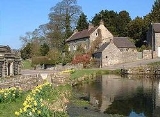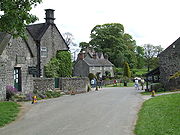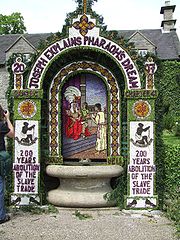
Tissington
Encyclopedia
Tissington is a village in Derbyshire
, England
. It is part of the estate
of Tissington Hall
, owned by the FitzHerbert
family since 1465. It is regarded as one of the most picturesque
English villages and is a popular tourist attraction, particularly during its well dressing
week. It also gives its name to the Tissington Trail
, a 13 miles (20.9 km) walk and cycle path which passes nearby. The Limestone Way
, another long-distance path and bridleway, passes through the village itself.
of 1086 as 'Tizinctun', having been given to Henry de Ferrers
by the King:
During the reign of Henry I
the estate passed to the Savage family. After the death of the last male heir, William le Savage in 1259 it was split between the families of the joint heiresses, the Meynells and Edensors. The Meynell's part of the estate was acquired in marriage by Nicholas FitzHerbert in the 1460s. During the reign of Elizabeth I
, Francis, the great-grandson of Nicholas, purchased the remainder from the heirs of Edensors. From then the village and estate has been wholly in the ownership of the FitzHerbert family

 In the centre of the village is Tissington Hall
In the centre of the village is Tissington Hall
, the seat of the FitzHerberts. A Jacobean
building built in 1609 by Francis FitzHerbert, replacing an earlier moated manor house, it is a Grade II* listed building.
The parish church
opposite the hall has a Norman
tower
and font
.
The majority of the other buildings in the village are built in the local vernacular
style, of which around 70% are listed buildings.
s each year. Six wells (Children's Well, Coffin Well, Hall Well, Hands Well, Town Well and Yew Tree Well) are decorated during the week of Ascension Sunday with pictures formed by pressing flower petals and other organic materials into a clay substrate. The pictures are usually on a Biblical theme reflecting current events or anniversaries. This tradition is often cited to date back at least to 1348, following the village’s escape from the Black Death
, which the villagers attributed to the purity of the water in its wells.

wrote some of his novel The Spiritual Quixote whilst staying in Tissington.
Derbyshire
Derbyshire is a county in the East Midlands of England. A substantial portion of the Peak District National Park lies within Derbyshire. The northern part of Derbyshire overlaps with the Pennines, a famous chain of hills and mountains. The county contains within its boundary of approx...
, England
England
England is a country that is part of the United Kingdom. It shares land borders with Scotland to the north and Wales to the west; the Irish Sea is to the north west, the Celtic Sea to the south west, with the North Sea to the east and the English Channel to the south separating it from continental...
. It is part of the estate
Estate (house)
An estate comprises the houses and outbuildings and supporting farmland and woods that surround the gardens and grounds of a very large property, such as a country house or mansion. It is the modern term for a manor, but lacks the latter's now abolished jurisdictional authority...
of Tissington Hall
Tissington Hall
Tissington Hall is an early 17th century Jacobean mansion house situated at Tissington, near Ashbourne. Derbyshire. It is a Grade II* listed building....
, owned by the FitzHerbert
Fitzherbert Baronets
The FitzHerbert Baronetcy, of Tissington in the County of Derby, is a title in the Baronetage of Great Britain. It was created on 22 January 1784 for William FitzHerbert, of Tissington Hall, Derbyshire. The FitzHerberts descend from Norman knights and from the 12th century FitzHerberts of Norbury...
family since 1465. It is regarded as one of the most picturesque
Picturesque
Picturesque is an aesthetic ideal introduced into English cultural debate in 1782 by William Gilpin in Observations on the River Wye, and Several Parts of South Wales, etc. Relative Chiefly to Picturesque Beauty; made in the Summer of the Year 1770, a practical book which instructed England's...
English villages and is a popular tourist attraction, particularly during its well dressing
Well dressing
Well dressing is a summer custom practised in rural England in which wells, springs or other water sources are decorated with designs created from flower petals...
week. It also gives its name to the Tissington Trail
Tissington Trail
right|thumb|200px|The Trail at the site of the former Tissington station, now a picnic site.The Tissington Trail is a bridleway and walk/cycle path in Derbyshire, England...
, a 13 miles (20.9 km) walk and cycle path which passes nearby. The Limestone Way
Limestone Way
The Limestone Way is a long-distance bridleway in Derbyshire, England. It runs through the White Peak of the Peak District National Park, from Castleton south east to Rocester over the county boundary in Staffordshire. It originally ran to Matlock, but was diverted to its current, longer route to...
, another long-distance path and bridleway, passes through the village itself.
History
Tissington ( Old English 'Tidsige's farm/settlement) is recorded in the Domesday BookDomesday Book
Domesday Book , now held at The National Archives, Kew, Richmond upon Thames in South West London, is the record of the great survey of much of England and parts of Wales completed in 1086...
of 1086 as 'Tizinctun', having been given to Henry de Ferrers
Henry de Ferrers
Henry de Ferrers was a Norman soldier from a noble family who took part in the conquest of England and is believed to have fought at the Battle of Hastings of 1066 and, in consequence, was rewarded with much land in the subdued nation.His elder brother William fell in the battle. William and Henri...
by the King:
"In Tizinctun Ulchel, Edric, Ganel, Uluiet, Wictric, Leuric, Godwin had 4 carucates of land for geld. Land for 4 ploughs. Now in the demesne there (are) 3 ploughs: and 12 villanes, and 8 bordars having 4 ploughs, and 1 mill of 3 shillings (value); and 30 acres (121,405.8 m²) of meadow. Underwood 1 miles (1.6 km) in length and 4 furlongs in breadth. In the time of King EdwardEdward the ConfessorEdward the Confessor also known as St. Edward the Confessor , son of Æthelred the Unready and Emma of Normandy, was one of the last Anglo-Saxon kings of England and is usually regarded as the last king of the House of Wessex, ruling from 1042 to 1066....
it was worth £4, now 40 shillings"
During the reign of Henry I
Henry I of England
Henry I was the fourth son of William I of England. He succeeded his elder brother William II as King of England in 1100 and defeated his eldest brother, Robert Curthose, to become Duke of Normandy in 1106...
the estate passed to the Savage family. After the death of the last male heir, William le Savage in 1259 it was split between the families of the joint heiresses, the Meynells and Edensors. The Meynell's part of the estate was acquired in marriage by Nicholas FitzHerbert in the 1460s. During the reign of Elizabeth I
Elizabeth I of England
Elizabeth I was queen regnant of England and Ireland from 17 November 1558 until her death. Sometimes called The Virgin Queen, Gloriana, or Good Queen Bess, Elizabeth was the fifth and last monarch of the Tudor dynasty...
, Francis, the great-grandson of Nicholas, purchased the remainder from the heirs of Edensors. From then the village and estate has been wholly in the ownership of the FitzHerbert family
Notable buildings


Tissington Hall
Tissington Hall is an early 17th century Jacobean mansion house situated at Tissington, near Ashbourne. Derbyshire. It is a Grade II* listed building....
, the seat of the FitzHerberts. A Jacobean
Jacobean architecture
The Jacobean style is the second phase of Renaissance architecture in England, following the Elizabethan style. It is named after King James I of England, with whose reign it is associated.-Characteristics:...
building built in 1609 by Francis FitzHerbert, replacing an earlier moated manor house, it is a Grade II* listed building.
The parish church
Parish church
A parish church , in Christianity, is the church which acts as the religious centre of a parish, the basic administrative unit of episcopal churches....
opposite the hall has a Norman
Norman architecture
About|Romanesque architecture, primarily English|other buildings in Normandy|Architecture of Normandy.File:Durham Cathedral. Nave by James Valentine c.1890.jpg|thumb|200px|The nave of Durham Cathedral demonstrates the characteristic round arched style, though use of shallow pointed arches above the...
tower
Tower
A tower is a tall structure, usually taller than it is wide, often by a significant margin. Towers are distinguished from masts by their lack of guy-wires....
and font
Baptismal font
A baptismal font is an article of church furniture or a fixture used for the baptism of children and adults.-Aspersion and affusion fonts:...
.
The majority of the other buildings in the village are built in the local vernacular
Vernacular architecture
Vernacular architecture is a term used to categorize methods of construction which use locally available resources and traditions to address local needs and circumstances. Vernacular architecture tends to evolve over time to reflect the environmental, cultural and historical context in which it...
style, of which around 70% are listed buildings.
Well dressings
An estimated fifty thousand people visit the village to view its well dressingWell dressing
Well dressing is a summer custom practised in rural England in which wells, springs or other water sources are decorated with designs created from flower petals...
s each year. Six wells (Children's Well, Coffin Well, Hall Well, Hands Well, Town Well and Yew Tree Well) are decorated during the week of Ascension Sunday with pictures formed by pressing flower petals and other organic materials into a clay substrate. The pictures are usually on a Biblical theme reflecting current events or anniversaries. This tradition is often cited to date back at least to 1348, following the village’s escape from the Black Death
Black Death
The Black Death was one of the most devastating pandemics in human history, peaking in Europe between 1348 and 1350. Of several competing theories, the dominant explanation for the Black Death is the plague theory, which attributes the outbreak to the bacterium Yersinia pestis. Thought to have...
, which the villagers attributed to the purity of the water in its wells.

Literary connections
Richard GravesRichard Graves
Richard Graves was an English minister, poet, and novelist.Born at Mickleton Manor, Mickleton, Gloucestershire, to Richard Graves, gentleman, and his wife, Elizabeth, Graves was a student at Abingdon School and Pembroke College, Oxford...
wrote some of his novel The Spiritual Quixote whilst staying in Tissington.

